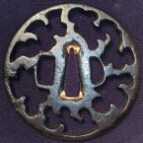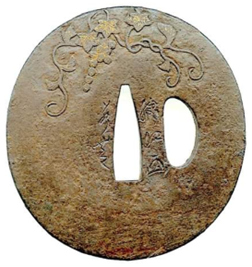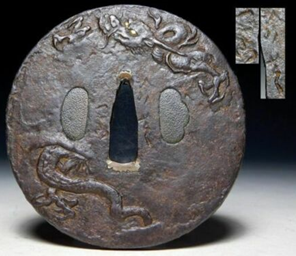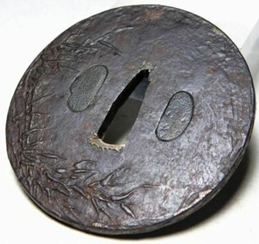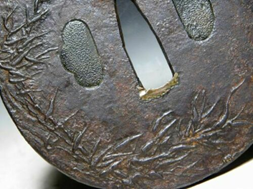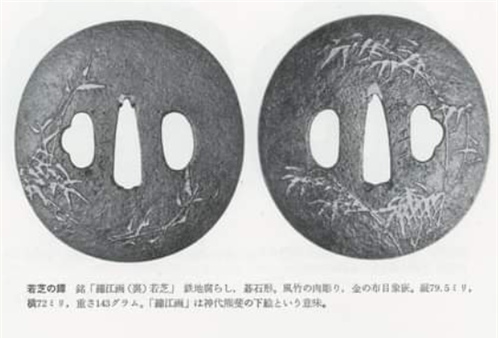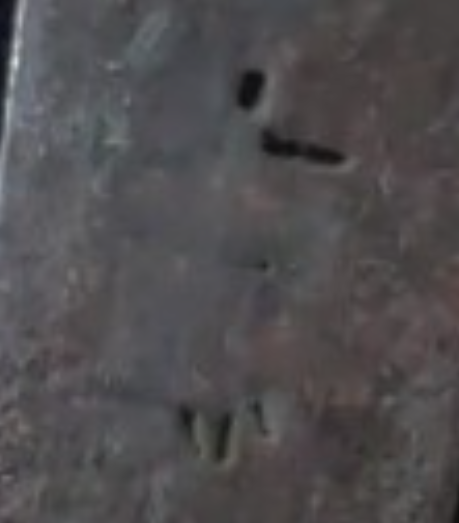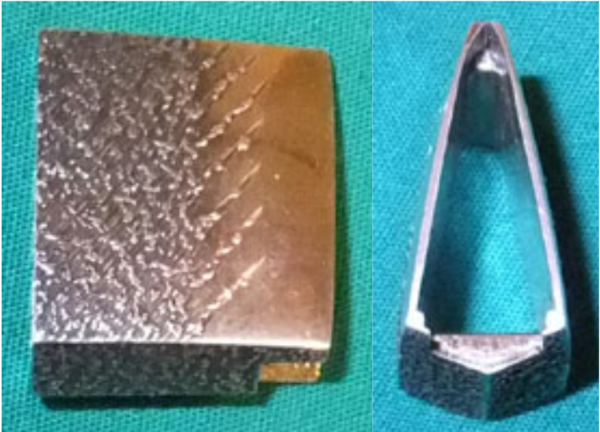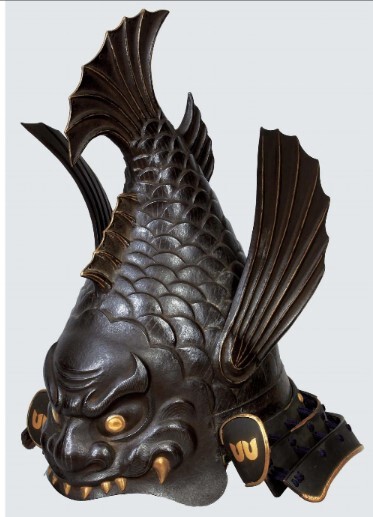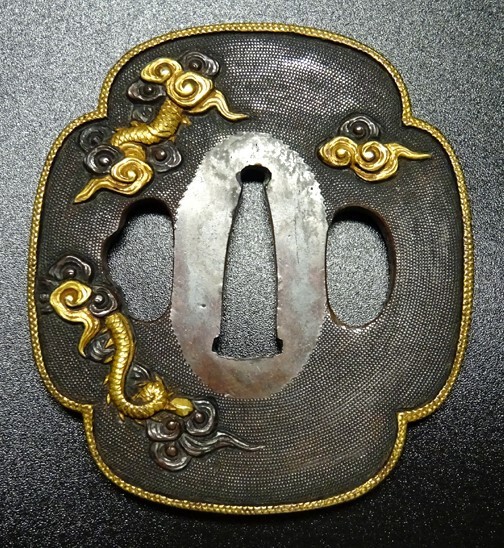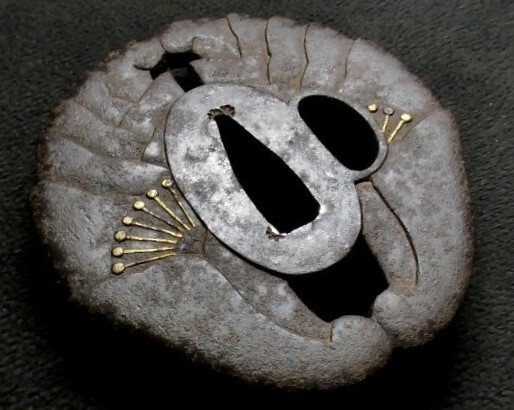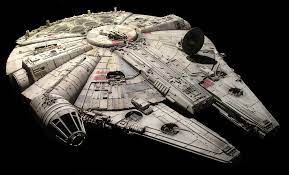-
Posts
594 -
Joined
-
Last visited
-
Days Won
10
Content Type
Profiles
Forums
Events
Store
Downloads
Gallery
Everything posted by GRC
-
This is my first time posting in this section after almost 2 years on the message board Does anyone recognize this one? It's on a tsuba with a lot of deformation from a yakite heat finish. Many thanks
-
I found another example of this smith/school's work. Very similar to the one Dale posted from the Victoria & Albert museum.
-
Looks legit to me Colin It's an excellent example of their work. I was tempted to buy it myself, and I kept the images from when it was available: The Jakushi or "Wakashiba" group are known for using acid etching to give some of their designs a more weathered, wispy, "painted with ink" look. That is especially true of the wind blown bamboo (which is a motif taken from a "suiboku Zenga" (Zen ink-painting) of windblown bamboo by Kumashiro Yuhi in the 1700s). The acid etching also frequently ends up revealing some of the folds in the layered steel near the mimi in certain locations. I think I can see those along the lower left and upper right sides on the ura side with the bamboo. Here's one of their etched ones. The squirrel with grape vines is a common motif, but very rare for these smiths. Note the mokume layers revealed at the bottom of the ura side: In my experience the etched ones are usually associated with the "Wakashiba" group of smiths. They often get lumped together with the Jakushi group. Although they have a lot of similarities, I think there's an aesthetic difference between the two... at least that has been my experience with the labels "Jakushi" and "Wakashiba". Unfortunately, I don't know what the actual relationship between the two groups is though... same group or splinter groups working in different locations? Try searching for "Wakishiba bamboo tsuba". It's actually fairly rare to have a dragon on one side and bamboo on the other. They are usually bamboo on both sides. Here's some more: The daisho pair above was also acid etched to enhance that "windblown" look. Congrats Colin, it's a great tsuba.
-
I really like the two copper alloy tsuba Vitaly. I'm glad someone got them (even though it wasn't me) Never saw the mei the first time round, so nice find there. Unfortunately I don't recognize it so can't help with that. Strange though, from the image, it kind of looks like someone inserted a square patch over the mei maybe... or is it just my imagination?
-
Nice pickup, and good work on the cleanup Jeremy I like the hefty look on that one.
-
Nice, congrats Alex! Actually, given its size, Jussi is probably right about it being fitted to a naginata.
-
Nicely done Stephen! I'm going to have to work on setting up something like that too... Thanks for sharing
-
from wikipedia : The yoroi-dōshi is an extra thick tantō, a short sword, which appeared in the Sengoku period (late Muromachi) of the 14th and 15th centuries.[4] The yoroi-dōshi was made for piercing armour[5] and for stabbing while grappling in close quarters. They have a thick triangular cross-section so they don't snap when thrust into armor. Here's a habaki for one to show the profile:
-
Another shachi Kabuto (helmet). There was a crazy amount of effort and detail put into these shachi kabuto. I figured I should repost the other two, previously posted by Steven K. and Barry H. respectively. It's nice to see them all together. I don't know anything about the history of kabuto styles and uses and should probably post these questions in the katchu section of the forum, but maybe someone who knows the answers could post a quick response Were elaborate helmets like these purely for pomp and ceremony in the Edo period? Did helmets like this even exist in the pre-Edo periods of war? I can't imagine that kabuto like these would ever be worn in battle.
-
That's a fair point Barry. Those definitely are feathers now that I look at them more closely, along with the background being swirling clouds rather than water or a mix of both. The carving on the dragon's back and tops of the wings looked kind of scale-like, plus I think Bonhams even listed them as shachi, so I just ran with it
-
Jean, I like your "Zen garden, raked gravel" themed tsuba. Very nicely detailed work I imagine it must have some interesting effects with light and shadows at different angles? ...and of course Dale manages to find a comparable Does Tasmania have a secret service? Dale, maybe you could opt to do that remotely... everyone seems to prefer that option these days But Jean's right, Dale would definitely be a good addition.
-
Ron, I hope you get the info you’re looking for Thanks for sharing.
-
Ya, I used the Chinese name, shishi, for the lion dog. They originated as guardian symbols in Chinese Buddhism. I learned that association a long time ago so it’s what I default to. Anyway, that one struck me as more of a lion than a tiger.
-
-
I would like to second Ron's observations on this one. The branches and leaves are way too detailed and crisp compared to other cast tsuba. Same with the crisp outlines of the raised mimi, the hitsu-ana, and even the tegane-ato. Bazz, that oddity looks like a "delamination". It's got a clear seam line along the left side of the "bubble" which looks like a layer of the plate has lifted but has not yet completely broken away. I don't think you'd see that combination of side by side features in a casting fault. I think the rough area along the left side of the nakago-ana is probably also a delamination, where the top layer broke free and left a rough crater-like area. It would also likely that this "chip" lifted off when someone widened the nakago-ana (leaving that raised lip along the sides). Casting faults tend to leave smooth voids or raised lumps in locations that don't align with tsuba's patterning. That's my 2 cents
-
-
they ran out of space for decorations on this one...
-
Great thread by the way here's another one with the ship:
-
On this point, I would suggest that it seems you misunderstood what I wrote. I was specifically referring to the use of the title, "the last word", when stating an opinion that wasn't supported by fact. The comment was about the action, not the person in general. I believe that I have not infringed on that NMB policy in any way. I would still make the case that it is foolish, unwise, misguided, to call an unsubstantiated opinion, "the last word". Anyone, no matter how intelligent or unintelligent, can commit a foolish act. We're all just people after all. I think the important part is how we respond to these missteps. Otherwise, I don't believe that any of the statements in my initial post are incorrect. They are thoughts that should be considered before bestowing too much "authority" onto a single person who is not an authority on this particular subject. The unfortunate use of the word "asinine" doesn't change that at all. I would love to see that idea followed by everyone... I'm sure we could collectively generate a long list of "unpleasant words" that have been posted by select individuals, across multiple threads related to this topic. This topic sure seems to get people heated up...
-
Sorry about that, I didn't mean to be overly disparaging by using the term asinine. In its pure definition, it takes on a fairly "extreme" connotation, so it could easily come across harsher than I intended, so definitely the wrong choice of word. I agree, that would be a perfectly apt description of his view on the topic.
-
Most people are aware that Star Wars was inspired by Kurosawa's, The Hidden Fortress, but who would have guessed that even the Millennium Falcon's design was directly influenced by a tsuba?
-
Yikes!, that one has seen better days...
-
I also noticed that Brian made a similar appeal to Ford's "authority" in the "wasp" thread a while back. It is a deeply flawed ideology and is precisely the crux of the problem in so many areas of Tosogu. There are far too many instances where ideologies are stated as though they are fact, when in reality many of those concepts were outright "conjurings" that were constructed by earlier writers about Tosogu, who we have largely accepted as "authorities". Let's call this "Appeal to authority" or something akin to "Sensei-ism". ie. "This must be true because "so and so" said it..." This is where I would appeal to everyone to adopt a more genuine "scientific approach" on all matters that deal with Tosogu so that we can collectively break down some of the constructs that don't seem to stand up to scrutiny. Larason, I have to point out that the "appeal to authority" that you are espousing is NOT how science works. No scientist should blindly accept someone's theory until some evidence is offered up to support it. Ford has not provided a single published or researched reference that supports his views on this subject. Plain and simple, his views on this topic are simply a hypothesis, until some evidence can be found to support his ideas. His perceived "absence of information" does not count as a positive affirmation of his own hypothesis. Furthermore, Ford is not an expert on the topic of cast iron of any kind. He is a goldsmith from the UK who makes decorative modern tsuba utsushi. Absolutely, he is a skilled craftsman (I offer a sincere congrats on the awards), however this topic does not relate at all to his skill set or area of expertise. The only overlap is the word "tsuba". Maybe if he received his training by a master Japanese kettle maker, I would give his hypothesis some more credit, but I still could not accept it as certain until evidence was provided. He is not an expert in modern cast-iron techniques, and is certainly not an authority on any of the Japanese casting techniques that were used during the Edo period (of which there are very few extant writings from the period). He is not a trained or published historian. He is not a trained or published anthropologist. And just because he lived in Japan for a few years, it does not make him an expert in Japanese culture (modern or otherwise). So where is his authority on THIS TOPIC? There is no factual evidence to support his view. He is simply offering an opinion, and because of perceived "authority", some people are just blindly accepting it as some sort of "truth". And posting his opinion under the title of "the last word" on the topic is completely asinine. If someone were to walk into a science conference to make a claim like that, with no supporting evidence, would be laughed out of the room. The problem that I see, is that the idea is being delivered as an absolute, and there is simply no justification for that. If the hypothesis was being presented as "I think that... or I suspect that..." then it offers up an opportunity for research and discussion. That's what we need more of, not more "sensei-ism". Most of the quotes that have been dug up by many members on the NMB, came from actual tsuba scholars and/or Japanese publications, that suggest that cast iron tsuba could have been produced during the Edo period. This is coupled with the fact that there was a growing trend toward "mass production" of tsuba and "ready made" tsuba during the mid to late Edo period. Sesko's reference to cast-iron kettle makers who made tsuba around the 1750s, was translated from Japanese historical records. I can't think of what the Japanese would gain by making up such a statement in their records, so in my view, that stands as legitimate evidence, not merely an opinion. Everyone is free to choose their beliefs of course, but we shouldn't let this degenerate into "picking sides", or resorting to "appeal to authority" without supporting evidence.
-
With regard to the “fragility of cast iron tsuba”: This point is completely irrelevant. We're talking about the EDO PERIOD, over 200 hundred years of peace, prosperity and increasing opulence with the growing wealth of the merchant class. There would never have been a need to wear a cast-iron tsuba to battle, so the potential for breakage would never have been a point of concern. So, where’s the issue? It simply doesn’t matter.
-
A counterpoint to Ford’s “smoking gun”: Ford (being the main proponent of the “post-Edo casting theory”) has been equally guilty of forcing his unsubstantiated opinions on the matter. The assertion that there were NO Edo-period cast-iron tsuba is pure conjecture on his part, and he has not been able to substantiate his claims with any substantive facts or references. I’m actually shocked that he presented his one and only quote, and called it a "smoking gun". "It maybe well here to dismiss, once for all, a theory sometimes advanced by writers in Europe that many of the elaborate guards of the fifteenth and sixteenth centuries were of cast iron.” The quote specifically refers to 15th and 16th century tsuba, so it has no relevance to what we are talking about... it's referencing a completely different period in Japan's history. Smoking gun? He has also made several claims along the way (starting back in his “last word thread”) that were patently false… like the idea that tatara could not reach the appropriate temperature to melt cast iron. Subsequent research on the topic shows this is clearly not correct. If anyone wants to see a long string of opinions with little to no academic rigor, along with a blatant attempt to shut down any discussion on the topic, feel free to read through Ford’s suggested “last word” thread. It is a fine example of how to subvert a series of legitimate questions, and how NOT to engage in fruitful discussion. Many people contributed to that mess, an unfortunately, some people have been swayed by the rhetoric, and old tropes that it contains. Ford is a wealth of information on many topics, and I appreciate his contributions in those areas. However, with regard to the specific issue of when cast-iron tsuba were produced, he’s just another guy with an opinion.


